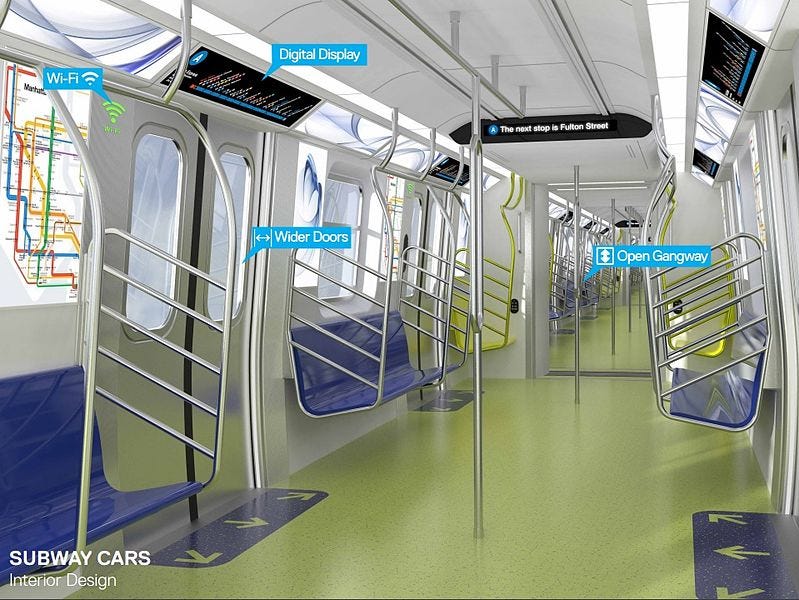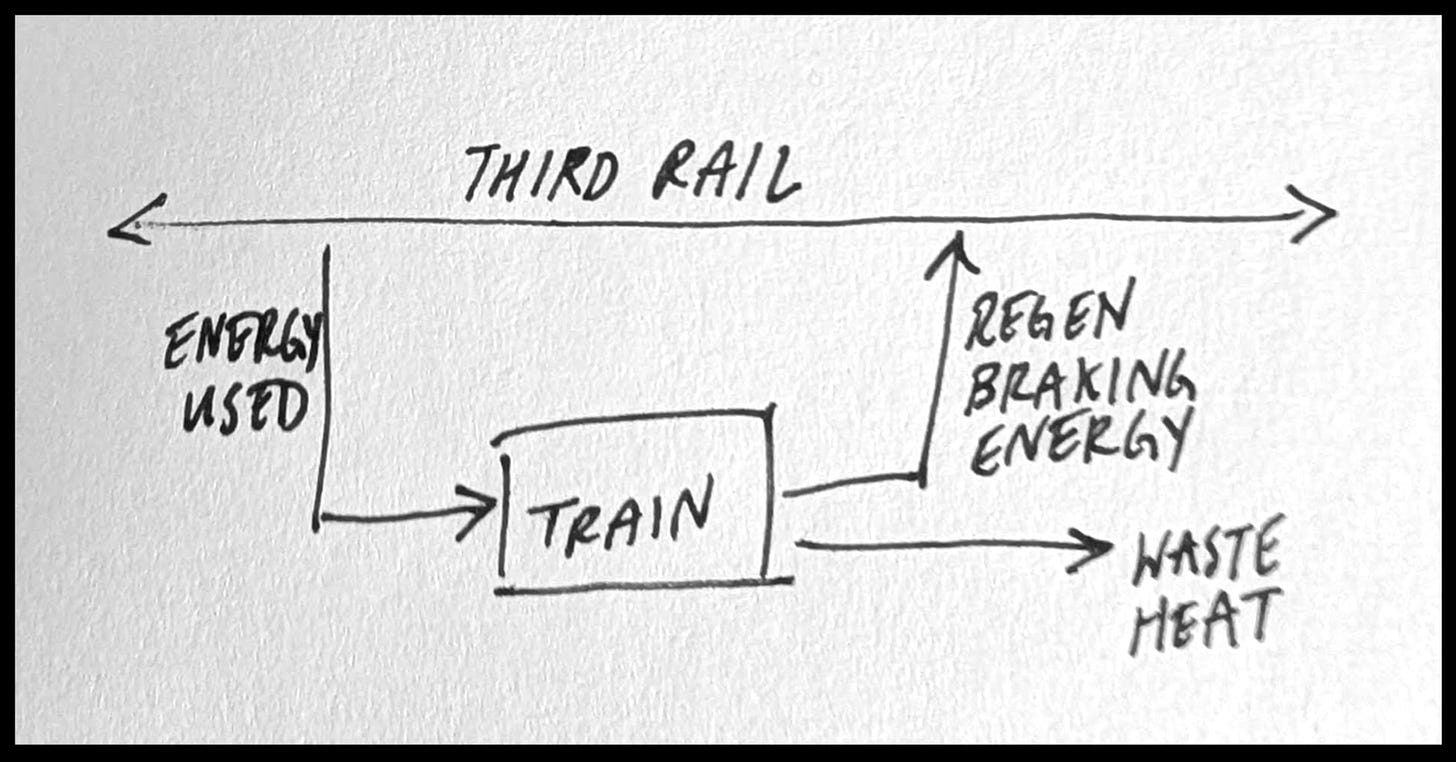What if the subway could heat our homes?
How the quest to cool the subway could lead to a new source of energy.
In my previous post, I explored why the subways are so hot. We diagnosed the problem—a combination of braking, air conditioning exhaust, and aging infrastructure that pumps heat onto the platforms. Now, let’s move from description to prescription: What can we do about it?
What you may not realize is that solutions to this problem aren’t just theoretical; many are already underway. My goal is to connect the dots on a surprisingly elegant two-part strategy: first, by exploring how today’s slow, often frustrating upgrades can make the subway cooler, and second, by revealing how we can one day capture that waste heat to help warm the very buildings we live and work in.
I see two primary paths forward, which can be summarized simply: reduce the heat, and reuse the heat.
How can we reduce the heat generated?
The most direct approach is to make functional improvements that increase the efficiency and quality of service. A more reliable, modern subway network would naturally be a cooler one. When trains run smoothly, they spend less time in the heat-generating cycle of braking and accelerating.
The Regional Plan Association (RPA) put forth proposals for modernizing the system and increasing reliability in its 2018 report, Save Our Subways.1 Many of the necessary upgrades also happen to be solutions for heat reduction.
Upgrade Aging Infrastructure
Much of the system's ambient heat comes from outdated technology. The linear fluorescent lights found in many stations are inefficient, have short lifespans, and radiate significant heat. To address this, the MTA began a system-wide conversion to cooler, more efficient LEDs in 2024, an effort expected to be completed in 2026.2
Additionally, a significant portion of the subway’s signal technology is nearly a century old. These antique systems not only generate waste heat, but are also a source of system delays. Upgrading from the old Fixed-Block Signaling—which acts like a series of traffic lights to allow one train to occupy a ‘block’ at any given time—to modern Communications-Based Train Control (CBTC) is a game-changer. With CBTC, trains constantly communicate their exact position and speed, allowing them to run closer together safely, reducing dwell times in stations and minimizing that stop-start cycle. Less time sitting at a platform means less heat dumped where passengers are waiting.
Lighter Train Cars
The design of the train cars themselves plays a crucial role. Since heat loss is proportional to mass3, transitioning to lighter trains would decrease power demands and, consequently, waste heat.
The introduction of open gangway trains, where you can walk from one end to the other without passing through doors, is a win-win-win. These designs provide more space for passengers, reduce the overall weight of the train, and improve safety by making it harder to subway surf.4 So far, 20 of the MTA’s 6,910 train cars have open gangways.5
How can we reuse the heat that is generated?
Now, for an idea I am quite passionate about: reusing heat. If you know me personally, you likely have heard me propose this with great enthusiasm. It’s an elegant solution that turns a problem into a resource.
Regenerative Braking
In a traditional braking system, a train’s immense kinetic energy is converted into heat through friction, and is radiated away to heat those of us standing on the platform. Regenerative braking captures that energy instead. By essentially running the electric motors in reverse as a train slows down, the system acts as a generator, converting the energy back into usable electricity.
As the laws of thermodynamics teach us, energy can’t be created or destroyed, but it can be transformed. Regenerative braking transforms kinetic energy into electrical energy, instead of letting it become waste heat.
This isn’t a futuristic fantasy, it’s already happening! The MTA has been incorporating this capability into new train cars for the last 20 years or so. As of last year’s Capital Plan, 67% of the entire fleet is regenerative braking-capable, with most of the remaining cars scheduled for replacement in the 2025-2029 window.7
So what’s the problem? We aren’t capturing all the energy we could be.
A 2022 NYSERDA study8 found that a significant amount of potential energy is still being lost. The electricity captured by a braking train is fed back into the third rail to be used by other accelerating trains nearby. But if there are no other trains in the immediate vicinity to use that energy, it has nowhere to go. In that case, it dissipates as… you guessed it, heat.
The solution? Energy storage. By installing batteries either along the tracks or inside the train cars, the regenerated electricity can be stored instead of wasted. That stored power can then be used when it’s needed, to help accelerate the next train that comes along or even power the stations themselves.
For a glimpse of what’s possible, look at Barcelona. Their metro system uses regenerative braking to cover about 33% of their trains’ energy needs, and to power 28 subway stations.9 They even route surplus electricity to nearby charging stations for electric vehicles, creating a new revenue source.
Thermal Energy Capture
Beyond regenerative braking, there is another powerful way to reuse the heat generated by the subway system: capturing it directly from air and redirecting it to something we actually want to be hot.
The foundational technology for this idea already exists right here in New York. The Second Avenue subway lies too deep underground to be ventilated by simple sidewalk grates. Instead, it uses a hydronic (water-based) system to cool its stations.10 The hot station air is blown over a cooling coil filled with cold water. The heat from the air is absorbed into the water, cooling the station. This now-warmed water is pumped to a building on the surface, where a cooling tower releases this captured heat into the atmosphere.
The MTA is already doing the hard work of capturing vast amounts of thermal energy. The crucial next step is to see that captured heat as a valuable commodity instead of waste. A team of students did just that, proposing that instead of venting all that energy into the sky, the hot water from the MTA’s system could be diverted to a nearby building to provide its hot water. It’s a brilliant application of a circular economy—one system’s wasted output is another system’s valuable input.
This type of large-scale solution is most feasible for new, deep-bore stations. For the vast majority of the system's century-old stations, a more modular technology called radiant cooling panels offer a promising path forward. Think of radiant cooling as creating a cool surface that pulls heat away from its surroundings, much like a cold window on a winter day. The thin panels have a closed loop of chilled water inside them, and would be installed on platform walls or ceilings. This creates a double cooling effect: they directly absorb radiant heat from passengers, providing immediate comfort, and they gently cool the surrounding air. Tests for a pilot program on the London Tube found that these panels could lower ambient temperatures by a remarkable 18-27 °F.11
Let’s scale up this vision and connect the pieces. Imagine not just one building, but an entire neighborhood connected to a shared network of underground pipes—a geogrid or thermal energy network.12 Such a system could allow buildings to efficiently share thermal energy. An office that needs A/C in the summer could dump its waste heat into the shared loop, which a neighboring apartment building could then draw from to heat its water.
This is where the concepts converge beautifully. The subway system, as a massive and consistent source of waste heat, could become the anchor of these neighborhood-scale thermal networks. The radiant cooling panels in the stations could even be powered by the geogrid itself. Instead of each station needing its own chiller unit, they could simply tap into the neighborhood’s shared loop for their supply of cold water. This creates a truly symbiotic relationship: the city helps cool the subway, and the subway helps heat the city.
Imagine a future where the waste heat from a braking train in Brooklyn helps warm the classrooms of a nearby public school. Or where the constant heat generated by a data center in Manhattan provides hot water for a low-income housing development. This is a system that creates a more just and resilient city—lowering energy costs for residents, creating new green-collar jobs, and transforming a large piece of public infrastructure into an active engine for decarbonization. It’s a tangible step toward building a more humane system, one where the invisible arteries of our city work in concert to help everyone flourish.
Can we put numbers on this?
Coming next time, I’ll attempt to back up these ideas with some rough calculations of cost and energy savings. Stay tuned!
In case you’re wondering, they’re all on the G line.



